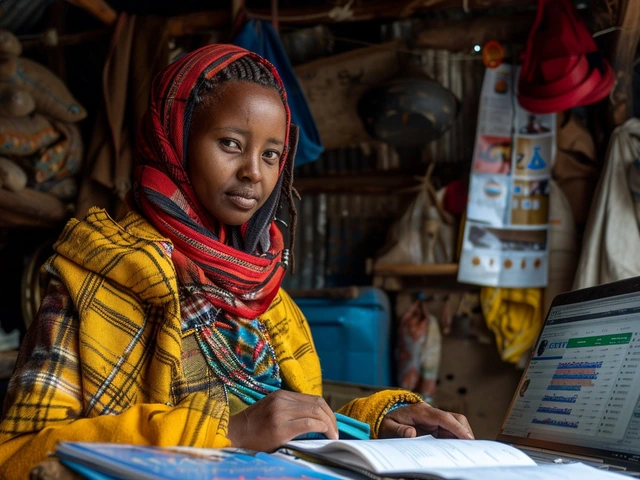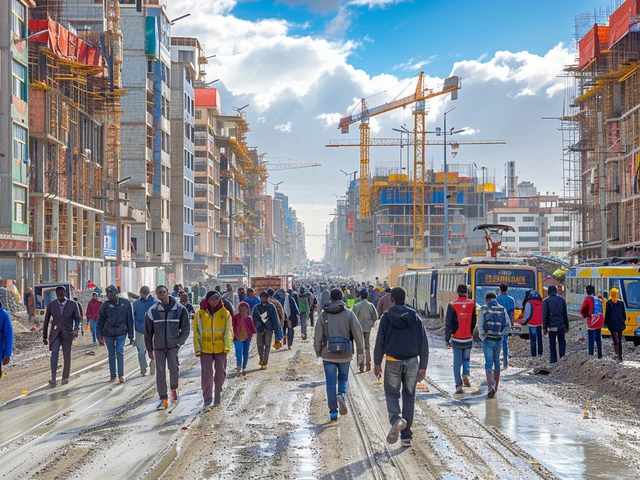Middle class income in Ethiopia is a topic that sparks much interest, especially as the country's economic landscape evolves. Defining what it means to be middle class here isn’t just about numbers; it's about lifestyle, aspirations, and the ability to thrive in a fast-changing environment.
The economic context of Ethiopia provides a backdrop for understanding middle class income. Life in this African nation comes with its unique economic conditions and challenges. While many Ethiopians live in rural areas and engage in agriculture, the thriving cities tell a different story about income and opportunities.
Income brackets are one way to label middle class status, but there’s more to the picture. In Ethiopia, household income significantly influences the quality of life, education opportunities, and access to healthcare. These economic markers give us a clearer picture of what middle class life looks like on the ground.
A close look at lifestyle and living standards reveals even more. For many middle class Ethiopians, aspirations include better education for their children, owning homes, and enjoying some modern conveniences. Their daily lives, filled with work and family commitments, paint a richer picture of this economic group.
What about the economic contributions of the middle class? They are vital to Ethiopia's economy, driving consumer demand, and fostering entrepreneurship. This segment supports local businesses, contributes to tax revenues, and plays a vital role in community growth.
But life as a middle class Ethiopian is not without challenges. Economic instability, inflation, and limited access to credit can make it tough to maintain or improve living standards. Yet, many remain optimistic, looking to the future with hope and determination. Understanding these dynamics helps to paint a full picture of middle class income in Ethiopia today.
- Defining Middle Class Income
- Economic Context of Ethiopia
- Income Brackets
- Lifestyle and Living Standards
- Economic Contributions of the Middle Class
- Challenges and Future Outlook
Defining Middle Class Income
What does it mean to be part of the middle class in Ethiopia? For many, it's a symbol of economic stability, a stepping stone towards greater opportunities. But pinning down an exact definition is challenging, as it is shaped by numerous factors, both economic and societal. Typically, middle class status is associated with earning levels that permit a comfortable lifestyle—covering basic needs while also allowing for savings and affordability of non-essential luxuries.
Middle class households in Ethiopia are often characterized by dual-income setups, particularly in urban settings. Significant distinctions arise between urban and rural areas. In cities like Addis Ababa, the middle class might include professionals such as teachers, healthcare workers, and small business owners, whose annual income ranges from $1,200 to $5,000. Meanwhile, in rural areas, where subsistence farming is predominant, the criteria might look different with lower income thresholds but similar lifestyle aspirations.
Income alone isn’t enough to define the middle class. Lifestyle factors are equally important. Middle class families typically have access to better education, healthcare, and housing. They often aim for home ownership, though this might be an apartment in urban centers or a piece of land in rural regions. Owning more modern conveniences like appliances, vehicles, and sometimes even pursuing leisure activities, also set them apart from lower-income groups.
Besides income and lifestyle, there's an aspirational aspect to being middle class in Ethiopia. This group often places a high priority on education, seeing it as a pathway to greater socioeconomic mobility. Many invest heavily in their children's education, often prioritizing private schooling and extracurricular activities to ensure a better future. In essence, the middle class believe in self-improvement and work diligently towards achieving their goals.
According to the World Bank, “Middle class households contribute significantly to the country's economic growth, often accounting for the largest share of consumer spending.”
Understanding the economic context of Ethiopia helps provide a fuller picture. Ethiopia has one of the fastest-growing economies in Africa, with a GDP growth rate averaging 7-10% annually over the past decade. However, wealth distribution remains uneven. Rapid urbanization and industrial growth are creating more opportunities for middle class incomes, although a large portion of the population still lives in poverty.
Economic contributions of the middle class are significant, too. They drive consumer markets, stimulating demand for goods and services. Middle class spending supports local businesses, encourages entrepreneurship, and thus fosters a more diverse economy. Moreover, they contribute to public revenue through taxes, which in turn funds essential public services.
Yet, defining the middle class isn’t only about economics. Social status, education levels, and even access to technology play a role. Middle class individuals often find themselves at a crossroads between traditional values and modern aspirations. This balance creates a unique identity, characterized by a blend of old and new cultural elements.
The Ethiopian middle class faces several challenges. Inflation, housing shortages, and limited access to banking and credit services can put pressure on their financial stability. Despite these hurdles, the middle class remains hopeful and resilient, driven by a strong work ethic and an unwavering belief in progress. Their aspirations and contributions are vital elements in shaping Ethiopia's future.
Economic Context of Ethiopia
Ethiopia, the second most populous country in Africa, is known for its rich history and cultural heritage. But understanding the *economic context* of this nation requires a closer look at its diverse economic activities, challenges, and prospects. The country has seen significant growth in recent years, driven by sectors like agriculture, manufacturing, and services. However, many Ethiopians still face economic hardships.
The agricultural sector remains the backbone of Ethiopia's economy, employing around 70% of the workforce. Coffee is a major export product, and the country is even known as the birthplace of coffee. Besides coffee, Ethiopia produces other agricultural goods like teff, sorghum, and fruits. While agriculture is fundamental, unpredictable weather patterns and lack of modern farming techniques can sometimes limit productivity.
The industrial sector in Ethiopia has been growing steadily, fueled by government initiatives to attract foreign investment. The construction boom in cities like Addis Ababa showcases the rising influence of the manufacturing and construction industries. Investments in infrastructure, such as roads, railways, and energy projects, have also contributed to this growth. Despite these advancements, the sector still faces challenges that include a lack of skilled labor and technological gaps.
Services play a crucial role in Ethiopia's economic context. Telecom, banking, and tourism are rapidly growing sectors, and the liberalization of the telecom industry has opened new opportunities. The service sector’s development is expected to continue, contributing significantly to the overall economic landscape.
"Ethiopia's economy has seen consistent growth, often exceeding 5% annually over the past decade," reports the World Bank. "However, poverty reduction remains a critical challenge."
Poverty and unemployment rates in Ethiopia are still high, especially in rural areas. Economic inequalities persist, with a significant gap between urban and rural populations. Many Ethiopians migrate to cities in search of better opportunities, which often results in urban overcrowding and challenges related to housing and public services.
Inflation is another factor affecting the middle class. Rising prices of goods and services put pressure on household incomes, limiting savings and investments. The government’s economic policies aim to control inflation through various measures, but fluctuating prices remain a concern for many families.
A deeper look at Ethiopia's economic context also includes considering its foreign trade. The country primarily exports agricultural products, while imports include machinery, vehicles, and chemicals. Trade deficits are common, necessitating efforts to boost local production and reduce dependency on imports. Economic reforms and international partnerships play a role in shaping trade policies.
Finally, foreign aid and remittances are significant contributors to Ethiopia's economy. Many Ethiopians working abroad send money back home, which helps in improving living standards for their families. Foreign aid from international organizations supports development projects, healthcare, and education, though it also raises questions about long-term sustainable development.
Ethiopia's economy is a blend of traditional practices and modern advancements. While challenges remain, ongoing efforts to improve agriculture, industry, and services provide hope for future growth. The economic context of Ethiopia today is complex but filled with opportunities for those who navigate it skillfully.

Income Brackets
Diving into the concept of income brackets in Ethiopia helps us understand how the middle class is economically defined. Ethiopia’s economic diversity means that these income levels can vary greatly depending on factors such as location, occupation, and education level. Generally, the middle class is characterized by their capacity to afford more than the basic necessities, allowing for a moderate level of discretionary spending and savings.
Understanding Ethiopian income brackets starts with looking at various data sources. For instance, an urban household typically earns between 6,000 to 10,000 Ethiopian Birr monthly to be considered middle class. Meanwhile, in rural areas, these figures might be lower due to different living costs and economic activities. This disparity highlights the complexity of defining middle class across different regions.
A World Bank study notes that middle class Ethiopians contribute significantly to the economy through their spending and saving habits. This segment of the population often invests in education, health, and housing, which reflects their priorities and aspirations. According to the report, “A thriving middle class is essential for sustaining economic growth, as it drives demand for goods and services, leading to job creation and higher income levels.”
A thriving middle class is essential for sustaining economic growth, as it drives demand for goods and services, leading to job creation and higher income levels.
Let’s consider an example. A family in Addis Ababa with two working adults might collectively bring in around 12,000 Birr monthly. This income bracket enables them to rent a modest apartment, send their children to private schools, and even set aside a portion of their income for savings or recreational activities. These are markers of middle class life that differentiate them from lower-income households, who might struggle with housing and basic needs.
Interestingly, the government’s role in shaping these economic status Ethiopia brackets cannot be overlooked. Through policies aimed at economic growth and development, various initiatives support the expansion of the middle class. For example, investments in infrastructure, education, and healthcare often trickle down to improving income levels for many families. This uptick contributes to a more stable and self-sustaining economy.
Income disparities between rural and urban areas highlight another critical aspect of middle class income in Ethiopia. In cities, the cost of living is higher, and so are the wages. Rural areas depend more on agriculture, where incomes are generally lower but so are living expenses. This variation complicates a uniform definition of the middle class, but it also shows the diverse economic landscape of the country.
Another vital point to mention is the impact of inflation on middle class living. Over recent years, inflation has eroded purchasing power, making it challenging for middle-income households to maintain their lifestyle. Items like food, fuel, and utilities have seen significant price hikes, affecting budgets and savings. Thus, staying in the middle class bracket requires not only earning well but managing expenses wisely.
Recent statistics reveal a growing middle class that currently represents about 20% of Ethiopia's population. This growth is indicative of the positive economic trajectories and efforts aimed at improving living standards. However, the middle class is not monolithic; it includes various sub-groups with distinctive financial behaviors, aspirations, and challenges. Understanding these nuances gives a richer, more accurate picture of life in this income bracket.
Lifestyle and Living Standards
Living as part of the Ethiopian middle class means aspiring for a better life, one that balances tradition and modernity. For many, this translates into owning a home, usually in burgeoning urban areas like the capital city, Addis Ababa. These homes might range from modest apartments to bigger houses in gated communities, symbolizing a step up in economic status.
Education is a crucial factor in the lives of Ethiopia’s middle class. Families put a strong emphasis on providing quality education for their children. This often means enrolling them in private schools or even international schools when possible. The pursuit of higher education is common, with many young adults aiming to study at reputable universities, both within Ethiopia and abroad.
The daily life of the Ethiopian middle class is filled with work and family commitments. For many, these commitments involve working in various sectors such as government, large corporations, or owning small to medium businesses. Access to modern conveniences is a significant marker of middle class living standards. Many households have electricity, running water, and increasingly, internet access. These amenities contribute to a more comfortable and connected way of life.
Healthcare access is another important aspect. Middle class families often take advantage of both public and private healthcare options to ensure they receive adequate medical care. This might mean visiting private clinics for day-to-day health issues and relying on public hospitals for more complex medical needs. The importance of health insurance is growing, as families seek to safeguard their health and financial stability.
Leisure and recreation are also vital components of middle class life. Urban centers boast a range of entertainment options, from cinemas and cafes to sports facilities and shopping malls. Families enjoy outings and social gatherings, reflecting a lifestyle that blends work with relaxation. Weekend travel is not uncommon, with many taking short trips to popular destinations like the historical town of Lalibela or the natural beauty of Lake Tana.
"The Ethiopian middle class is transitioning rapidly, embracing modern lifestyles while staying rooted in cultural traditions," says an expert from the African Development Bank.
Diet and food habits reveal much about lifestyle and living standards. Middle class families typically enjoy a diet that includes both traditional Ethiopian dishes and a variety of international foods. Eating out at restaurants, which serve everything from Italian pasta to Indian curry, is becoming more common. This variety of food choices signifies a more open and diversified lifestyle.
The economic contributions of the Ethiopian middle class cannot be overlooked. By patronizing local businesses, investing in real estate, and participating in various economic activities, they play a significant role in driving the country's growth. Their consumption habits, coupled with a desire for better living conditions, help foster a robust economy.
Social and community involvement is another hallmark. Many middle class individuals are active in local community organizations, charitable activities, and religious groups. This engagement helps to strengthen social ties and build a sense of community and mutual support.
With inflation and economic changes, maintaining this lifestyle can be challenging. Many families remain hopeful and resilient, constantly seeking ways to improve their living standards. This adaptive spirit is a defining feature of Ethiopia’s middle class, making them a critical component of the nation’s socio-economic fabric.

Economic Contributions of the Middle Class
The middle class in Ethiopia is a key driver of economic growth and stability, contributing in various ways to society. Their roles extend beyond just consumer power; they are integral in fostering entrepreneurship, supporting local industries, and encouraging innovation. For many middle class Ethiopians, the goal to maintain or improve living standards pushes them to invest in education, health, and property, which in turn spurs economic activities.
One major area of their impact is consumption. With higher disposable income compared to lower-income groups, the middle class spends more on goods and services. This increased demand drives production and creates jobs. Markets for electronics, fashion, dining, and entertainment thrive because of middle class spending. Local businesses, from small shops to medium enterprises, benefit greatly from this patronage, which supports a cycle of economic growth. Owning homes and investing in construction also adds significant value to the economy.
Another crucial contribution is in the realm of entrepreneurship. Middle class individuals are often at the forefront of new business ventures. Their ability to access capital, be it through savings or loans, allows them to start small or medium enterprises. These businesses not only generate employment opportunities but also introduce new products and services to the Ethiopian market. For instance, middle class entrepreneurs in the tech sector are making strides in digital innovations that have the potential to enhance various industries, including agriculture, education, and healthcare.
The middle class also plays a vital role in the education sector. They invest heavily in their children’s education, enrolling them in private schools or supplementary classes to provide better opportunities. This focus on education cultivates a skilled workforce necessary for the country's development. According to a report by the Ethiopian Ministry of Education, enrollment in secondary and tertiary education has been steadily increasing, largely due to the commitment of the middle class to ensure higher education for their children.
Healthcare is another significant area where the middle class makes a substantial difference. They tend to seek better healthcare services, often preferring private hospitals and clinics over public ones. Their willingness to pay for quality healthcare supports the private healthcare sector and encourages improvements in services and facilities. This demand has led to an increase in private healthcare providers, giving more choices to citizens and helping elevate health standards across the country.
Tax revenues generated by the middle class are also a major economic contribution. As regular taxpayers, their contributions provide the government with essential funds for public services and infrastructure development. This financial input is crucial, given Ethiopia's need for rapid development in various sectors, including transportation, communications, and energy. Middle class taxpayers therefore play a part in building the nation's foundations.
Mulugeta Alemayehu, an economist with the Ethiopian Development Institute, has noted, "The middle class is the backbone of our economy. Their spending habits, entrepreneurial spirit, and commitment to education and healthcare are key contributors to our nation's growth."
In understanding the broader impact, it’s evident that the Ethiopian middle class is pivotal not just in economic terms but also socially and culturally. Their consumption patterns, emphasis on education, and health investments foster a more dynamic and progressive society. As Ethiopia continues to develop, the role of the middle class will be even more critical in shaping the future economic landscape of the country.
Challenges and Future Outlook
The middle class in Ethiopia, despite its growth, faces significant challenges that often hinder progress. One major obstacle is economic instability. Inflation rates in Ethiopia can be unpredictable, making it difficult for middle class families to plan their finances effectively. Prices for essential goods can soar, putting a strain on household budgets. This unpredictability forces families to constantly adjust their spending and savings, often impacting their overall quality of life.
Another substantial challenge is limited access to credit. Many middle class Ethiopians find it difficult to secure loans, whether it's for buying a home, starting a business, or furthering education. The stringent requirements and high-interest rates set by banks make borrowing a risky endeavor. Without access to affordable credit, many are unable to invest in opportunities that could improve their economic standing and contribute to the country's growth.
Employment insecurity also plays a significant role in the struggles faced by Ethiopia’s middle class. While there are job opportunities in urban areas, the job market is highly competitive, and many positions do not offer long-term stability. The absence of job security means that middle class individuals must constantly seek new employment, often moving from one job to another and lacking a steady income.
Education remains both a challenge and a hopeful area for the future. While many middle class families invest heavily in their children's education, the quality and accessibility of educational institutions vary widely. Public schools often lack resources, and private schools can be prohibitively expensive. This disparity creates a significant barrier to achieving upward mobility, as education is a key factor in breaking the cycle of poverty.
Healthcare access is another critical issue. While Ethiopia has made strides in improving healthcare infrastructure, middle class families still face challenges in accessing quality medical care. Public healthcare facilities are often overcrowded and underfunded, leading many to seek private care that can be expensive. The financial burden of healthcare can be overwhelming, especially when dealing with chronic or serious illnesses.
Despite these challenges, there is optimism for the future. The Ethiopian government and various international organizations are working to address these issues through policies aimed at economic stability, improving access to credit, and investing in education and healthcare. Ethiopian income levels are expected to improve as these initiatives begin to take effect.
"The middle class in Ethiopia has the potential to drive the country’s economic development significantly," says Dr. Alemayehu Geda, an economist at Addis Ababa University. "Creating a conducive environment for them is essential."The future outlook for Ethiopia’s middle class is also bolstered by the rise of technology and innovation. The growth of the tech sector offers new job opportunities and avenues for entrepreneurship. Many young professionals are turning to startups and small businesses, leveraging the digital economy to create sustainable livelihoods. This shift not only promotes economic growth but also provides a buffer against traditional market instability.
Perhaps most importantly, the resilience and determination of the Ethiopian middle class cannot be understated. Despite the challenges they face, many remain hopeful and committed to improving their lives and contributing to their communities. They invest in education, seek better job opportunities, and advocate for better policies. This spirit of perseverance will be a key driver in overcoming the current challenges and achieving a brighter future for Ethiopia's middle class.

 Understanding the Minimum Salary in Ethiopia: Key Facts and Insights
Understanding the Minimum Salary in Ethiopia: Key Facts and Insights
 The 7 Essential Occupations: A Deep Dive into Career Choices
The 7 Essential Occupations: A Deep Dive into Career Choices
 Understanding the Major Health Concerns in Ethiopia
Understanding the Major Health Concerns in Ethiopia
 Top Ways to Earn Money Online in Ethiopia: A Comprehensive Guide
Top Ways to Earn Money Online in Ethiopia: A Comprehensive Guide
 Is Ethiopia Still Considered a Third World Country in 2024?
Is Ethiopia Still Considered a Third World Country in 2024?
Kim Chase
August 20, 2024 AT 17:40Hey folks, just wanted to throw in a thought – the Ethiopian middle class is kinda the bridge between the old‑school agrarian vibe and the new hustle in the cities. They’re the ones who can actually afford a bit of extra, like a phone or a decent school for the kids, and that ripple effect kinda lifts whole neighborhoods. Sure, there’s still a lot of struggle, but seeing more families getting into small trades or opening corner shops is a solid sign that the economy’s getting a bit more balanced. Keep sharing those success stories, they help people stay hopeful and keep the momentum going.
David Werner
August 23, 2024 AT 01:13Look, what they don’t tell you is that the so‑called "middle class boom" is being propped up by shadowy overseas investors who are quietly buying up real estate and siphoning cash through shell companies. The inflation spikes, the credit crunch – it’s all part of a grand design to keep the populace dependent while the elite line their pockets. Don’t be fooled by the glossy stats; the underlying system is rigged and the average Ethiopian is being used as a pawn in a larger geopolitical chess game.
Paul KEIL
August 25, 2024 AT 08:47From a macro‑economic perspective the emergent Ethiopian middle bracket exhibits a consumption elasticity that aligns with neoclassical growth models while simultaneously facing structural bottlenecks in credit access and labor market fluidity
Horace Wormely
August 27, 2024 AT 16:20The data presented about income brackets aligns with known statistical distributions, yet the article could benefit from clearer definitions of the thresholds used for "middle class" classification. Additionally, reference to primary sources would improve verifiability.
christine mae cotejo
August 29, 2024 AT 23:53It is fascinating to observe how the contours of Ethiopia’s middle class have begun to transform over the past decade, reflecting both the nation’s remarkable GDP growth rates and the persistent challenges that continue to shape everyday life. For instance, the increased ability of many urban families to enroll their children in private schools not only signals a shift in educational aspirations but also drives a thriving market for supplemental tutoring services, which in turn generates additional employment opportunities. Moreover, the steady rise in home ownership within Addis Ababa’s expanding suburbs highlights a growing appetite for real estate investment, a trend that fuels construction activities and stimulates demand for related industries such as cement production, electrical installations, and interior design. However, one cannot overlook the disproportionate impact of inflation on essential commodities; price surges in staple foods like teff and injera erode disposable income, compelling many households to reallocate savings toward basic sustenance rather than discretionary spending. In parallel, limited access to affordable credit continues to constrain entrepreneurial endeavors, as banks often impose stringent collateral requirements that many middle‑class entrepreneurs cannot satisfy, thereby stifling potential business expansions. Yet, despite these constraints, there is an observable resilience within this demographic, evident in the proliferation of micro‑finance initiatives and community‑based savings groups that aim to bridge the credit gap. These grassroots financial mechanisms not only provide capital for small enterprises but also foster a culture of collective responsibility and risk sharing. On the health front, the dual reliance on public hospitals for major procedures and private clinics for routine care exemplifies a hybrid approach to healthcare utilization, reflecting both confidence in the quality of private services and the economic reality of managing medical expenses. Socially, the middle class is increasingly engaging in civic activities, from participation in local development committees to voluntary contributions toward neighborhood clean‑up projects, displaying a commitment to societal improvement that transcends individual gain. Considering the broader economic landscape, the important role of remittances cannot be understated; funds sent from diaspora communities often serve as a financial cushion that supports education, housing improvements, and small business seed capital. Finally, looking forward, the entrenchment of digital technology-evident in the rapid adoption of mobile banking and e‑commerce platforms-offers a promising avenue for further economic integration, potentially mitigating some of the traditional barriers to market entry. In sum, the Ethiopian middle class stands at a crossroads where opportunity and adversity intersect, and its evolution will undoubtedly shape the nation’s socioeconomic trajectory for years to come.
Douglas Gnesda
September 1, 2024 AT 07:27I think it’s worth highlighting how the expansion of the middle class feeds directly into Ethiopia’s fiscal health. When more households start paying taxes on higher incomes and increased consumption, the government gains additional revenue streams that can be redirected toward infrastructure projects-think roads, railways, and telecom upgrades. These improvements, in turn, create a virtuous cycle by attracting foreign direct investment and boosting local entrepreneurship. It would be useful to see more granular data on how much tax revenue has risen alongside middle‑class growth, as well as any policy measures that have been introduced to encourage reinvestment of those funds.
Abhijit Pimpale
September 3, 2024 AT 15:00The middle‑class segment now accounts for roughly 20 % of Ethiopia’s population, translating to about 23 million individuals based on the latest CIA World Factbook figures.
Eric DE FONDAUMIERE
September 5, 2024 AT 22:33Wow, reading this made me super pumped! The rise of the middle class is like a rocket blast for the whole economy-more shops, more jobs, more vibes. I’m especially stoked about those new tech startups popping up in Addis; they’re totally changing the game. Let’s keep that momentum going, guys!
Pauline Herrin
September 8, 2024 AT 06:07While the article provides a comprehensive overview, it falls short of critically examining the systemic disparities that persist despite the reported growth of the middle class. The reliance on anecdotal evidence rather than rigorous econometric analysis weakens the argument.
pradeep kumar
September 10, 2024 AT 13:40The piece glosses over the fact that credit access remains a bottleneck; without affordable loans, many aspiring entrepreneurs will stay stagnant.
love monster
September 12, 2024 AT 21:13Great breakdown! It’s encouraging to see how education and health investments are becoming priorities for families. Keep an eye on how community mentorship programs can further amplify these gains.
Christian Barthelt
September 15, 2024 AT 04:47Interesting take, but I’d argue the data points to a saturation point where additional middle‑class growth may not translate into proportional consumer spending, especially if inflation outpaces wage gains.
Ify Okocha
September 17, 2024 AT 12:20Even if you paint a rosy picture, the reality is that most of these so‑called "middle‑class gains" are superficial and won’t survive without systemic reforms.
William Anderson
September 19, 2024 AT 19:53They live in a bubble.
Sherri Gassaway
September 22, 2024 AT 03:27One might wonder if the notion of a "middle class" is itself a construct that both empowers and confines, offering a sense of progress while masking the deeper currents of inequality that persist beneath the surface.
Milo Cado
September 24, 2024 AT 11:00Absolutely inspiring to see the middle class thriving! 🌟 Let’s keep supporting each other and building a brighter future for Ethiopia. 😊